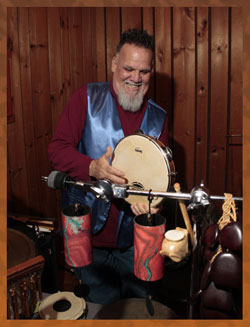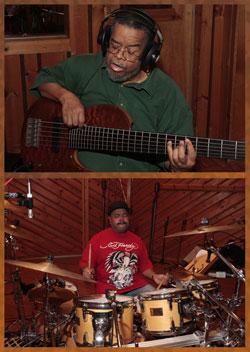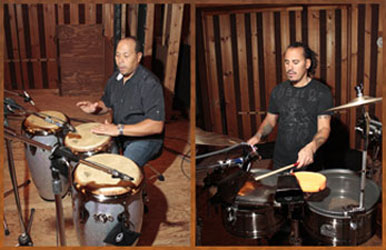

|
Soundclip:
|
| See Steve's Hand-Written Lead
Sheet |
|
Steve
Khan's
lead
sheet: As the demo began to take shape, and the song form and the solo format seemed to make some sense to me, I was still haunted by the sensation that something was missing. After great soul-searching, for me, there was only one solution, and that was to contact Manolo Badrena and to see if he could possibly create one of his unique chants that would bring all the various and disparate elements together as one. We finally spoke and he seemed very interested in trying to come-up with something.  But, he said that it would take him a while as he then was touring quite a bit with pianist, Ahmad Jamal. That was in late July of 2010!!! Manolo didn't return from a European tour with Ahmad until August 20th. Finally, on September 13th, a Monday, Manolo and I got together, we sat alongside my computer, and I played him those open sections of the demo. But, he said that it would take him a while as he then was touring quite a bit with pianist, Ahmad Jamal. That was in late July of 2010!!! Manolo didn't return from a European tour with Ahmad until August 20th. Finally, on September 13th, a Monday, Manolo and I got together, we sat alongside my computer, and I played him those open sections of the demo.I knew that I was hoping for something, sung in Spanish, that would be very rhythmic, and that the lyrics would sit on the fat parts of the groove. Needless to say, I wanted it to be very much à la James Brown, but that's not always the way that Manolo hears things. He broke out some pieces of paper with scribbled words here and there, and we commenced to go through the various ideas. We got through 2-3 of them, and I felt like we were in trouble. I heard lyrics that bordered on Rap and other things, but nothing was close to what I had been hoping to hear. So, as politely as I could express it, I had to say, "O.K., well, have you got anything else?" And that's when he pulled out the fragments that eventually became "María Mulambo." As a title, "Some Assembly Required" was then history! By the time that we had parted ways, we had two distinct choruses, and I felt that I had notated all the melodic content correctly, and all the lyrics, in Portuguese. Some days later, I realized that we had to come up with a chant for the Fade, which eventually became letter [F]. However, the process was not done yet, because now the demo had to be completed with Rob Mounsey singing a version of Manolo's lyrics so that Manolo himself could hear them, and then learn them for a later date. Having worked with Manolo on his vocals before, I knew that this was not going to be an easy, painless task! Perhaps the first such piece that we experimented with in this way was the title song from the CD, "CASA LOCO" - and yes, the title is extremely poor Spanish. It should have been titled "Casa Loca" - but I knew a lot less about the Spanish language then. That piece clocked-in at 12:32, and includes one of the great, great drum solos ever recorded. It was played by Steve Jordan. Some years later, we finally recorded another series of songs in this style for the CD, "PUBLIC ACCESS"(1989). Those songs became: "Sisé"; "Kamarica"; "Botero People"; and "Mama Chóla." All featured the voice and lyrics of Manolo Badrena, plus extended soloing from the group. If you have been following along with this story so far, you now know that to put together such a piece of music requires a great deal of time and patience, and, in this world, as it presently exists, both of those commodities are in short supply for me. Trying to work with Manolo, to create what is needed from him, becomes more difficult with each passing year. But, that stated, I am thrilled with the results, and very proud of what we have now created with "María Mulambo." Why did Manolo's inspiration lead him to write something with primarily Brasilian Portuguese lyrics? I have no idea, none at all. But, when he presented me with various vocal and melodic ideas for these sections, this was the one that spoke to me! So now, we have a piece of music that joins together: James Brown; Afro-Cuban 6/8; the wondrous music of Brasil; and, of course, the atmospheres of Eyewitness. Put 'em together and what have you got? "Bibbidi-bobbidi-boo"!!! Pomba gira María mulambo echa canela con tua cadeira bate teu corpo asim de maneira quente [B2] Se acaba la noite, a dormir menina bonita mais zé pilintra quere jogar Mais no hay ninguém aqui não, não, não gatinha BOM(!), María Mulambo ficó [F] Fade María mulambo, María mulambo, María mulambo e gira mundo There are many great percussionists in this world, a few of them can play freely, and float in-and-out of any music - and, of course, there are great vocalists of all types, and of all nationalities in this world - but, to find all of this, and in one person, that is NOT such an easy task. Had I never met Manolo? None of this would have been possible. The results are certainly not everyone's taste, but this is, for me, one of the signature musical moments on "PARTING SHOT." Though everyone had heard the demo of this tune, on which Rob Mounsey sang the vocal parts, no one, except me, had actually heard what Manolo was going to sound like, and do, when the "red light" went on. His adventures in percussion, and his shouts of encouragement were all essentially recorded live as we played together on that Sunday, November 7th, 2010. But, his final vocal performances of the crucial melody sections were not performed and recorded until Monday, November 15th, 2010 at Rob Mounsey's 333 Studios in downtown New York. It was then that the piece finally began to round into its now final shape.  The very last little detail that I added to the structure of the piece was another small 2-bar break, that appears after the guitar solo, and after a reprise of both letters [C] & [D]. If you look at bars 3-4 of [A] on Pg. 5, you can see the break. You can hear it at about 6:53 in the track. The reason for the break, and its placement, was simple, I felt that after all that relentless groovin', it needed to stop for a moment. Rather than applying the stop right as the section began, I wanted everyone to think that things were just going to continue as they had been. So, that's why the break appears in bars 3-4. The very last little detail that I added to the structure of the piece was another small 2-bar break, that appears after the guitar solo, and after a reprise of both letters [C] & [D]. If you look at bars 3-4 of [A] on Pg. 5, you can see the break. You can hear it at about 6:53 in the track. The reason for the break, and its placement, was simple, I felt that after all that relentless groovin', it needed to stop for a moment. Rather than applying the stop right as the section began, I wanted everyone to think that things were just going to continue as they had been. So, that's why the break appears in bars 3-4.Just as Rob and I had programmed the demo, the rhythm section would be introduced one by one. As the [I] section begins, we have the main rhythm guitar part, on the right side of your stereo, played by my ESP Strat, and direct into the console, joined together with Anthony Jackson's rendering of the 2-bar bass groove that I had written-out for him, and Dennis Chambers' rock steady drum groove. With each successive 4-bar passage, another instrument joins in. In sequence, they are: the 2nd rhythm guitar, on the left side of your stereo, which I called "Mr. Snappy," because it was all single-notes played with a fingernail on my right-hand. This part was also pre-recorded with the same ESP Strat. Then, the cross-rhythms begin to enter. Bobby Allende's conga was next. 4 bars later, the chekere enters. And finally, where you see [On Cue] written on the lead sheet, Marc Quiñones and his timbal join in, and the Afro-Cuban 6/8 has met "Doing It To Death"!!! On the original version of that R&B classic, there isn't a chord change until about 4-minutes into it. The whole tune is an F7(9) groove, that eventually goes down to D7(9). The chord movement of going down a minor 3rd is hugely important to "María Mulambo" as well. The [I] section kicks us off in A7(9), and the break figure throws us down a whole-step to G7(9). We stay there from [A] through [A3], but at [A4] we go down a minor 3rd to E7(9). After that, for [B], we go up a 1/2-step to F7(9), and the harmonic sequence of the [A] sections holds true here as well. What transpired over the full 10-minutes was not exactly what I thought was going to happen. Again, I am compelled to use the quote from James Taylor, where he roughly said this: "the first time a song gets played is when it's recorded." So, other than a run-through or two, what you now hear is really the first time that we ever played "María Mulambo" all the way through. What things surprised me? Though I really didn't realize it at the time, I never, ever expected that Anthony would stick to the little 2-bar bass part that I had written out for him. He never sticks to what I have written for too long. I never spoke to him about it, and we haven't discussed it since. I have no idea why that happened. He really doesn't begin to break away from it until the Fade. However, on the very, very positive side, the groove that Anthony, Dennis, Bobby and Marc achieved is simply relentless, and, in that regard, I could not have asked for more. It's just foot-stompin' good!!! The 'looseness factor' clearly comes from Bobby and Marc, they are the main ones reacting and commenting upon what I was playing, and what is going on in the piece in general. As for the totally live contributions of Manolo? Wow, what can I say? On this piece, I guess one could say that he "threw everything in but the kitchen sink!!!" His spirit is just everywhere, and his shouts of encouragement just lift the performance to another level, another zone. Some of what he was saying is just beyond hysterical, each time that I hear this tune, I can't stop smiling and laughing. As I continue to say, Manolo Badrena is a totally unique musical spirit! You might be wondering to yourselves, "How were you able to make a solo section that could be loose enough for the way that you guys like to play, without creating uncertainty as to when the next section was coming?" A-ha!!! Good question!!!  This required some pre-production planning as well. At Rob Mounsey's studio, as we were finalizing the demo, now a 'play-along' track, I recorded my voice saying two things, two numbers: "8" and then, "4"!!! So, in our headphones, everyone would hear my voice, and would then know that we had 8 bars to go, and then 4 bars to go, before we had to make the chord change at letter [E2]. Doing that, this way, enables everyone to just play, to play freely, and without having to count bars. I think that this is the best way to optimize your chances for good results. This required some pre-production planning as well. At Rob Mounsey's studio, as we were finalizing the demo, now a 'play-along' track, I recorded my voice saying two things, two numbers: "8" and then, "4"!!! So, in our headphones, everyone would hear my voice, and would then know that we had 8 bars to go, and then 4 bars to go, before we had to make the chord change at letter [E2]. Doing that, this way, enables everyone to just play, to play freely, and without having to count bars. I think that this is the best way to optimize your chances for good results.Looking back at the way that the solo section unfolded, I have to repeat that this was really the 1st time that we were all playing through the entire piece of music. But, over the years, Anthony and I have developed a particular communication style, way of making music together, and that is what I expected to happen here. I was certain that he would begin to break away from the written bass part. But, it never happened. So, I would throw a phrase out, expecting something to come back at me from A.J., but nothing like that ever happened. I could hear Bobby, Marc and Manolo commenting and reacting, but the next thing I knew, the section had come to an end, and we were moving forward. For that reason, from an improvisational perspective, the guitar solo has a flavor very rooted in R&B with Jazz flavorings. I was anticipating that it would have been the exact opposite! As James Farber and I were doing the final mix of this piece, a process which is always torture for me, I began to hear things that I wish that I had approached differently. My approach to the mixing process is to never spend too much time in the actual control room with the engineer. My reason for this is that, I want to always hear the piece with fresh ears. So, in this case, when James comes to get me in the lounge, I am ready to listen, and to offer some comments solely based upon how I am reacting to what I am hearing. We had a little space set-up for me out in the studio area of Avatar Studio 'C', where we mixed, and there I had my own speakers from home set apart at the exact distance that I listen to them in my music room. Still, to have to sit through a 10-minute piece, and concentrate is not easy for me. Each time we reached the Fade, letter [F], I found myself wondering "Why?" I hadn't played more there - why had I stuck to the melody in between Manolo's repeated chant? Again, I believe that it was just a case of the fact that we had recorded a performance of us playing the tune for the very first time, and decided to keep it. I guess I am also used to Anthony treating "fades" as if they are his own personal harmonic and rhythmic playground, and I was expecting some of that too. So, I just wanted to hold my melodic part together in order that he would feel free. Looking back, if I could do it again, I would just go for it and play out! One of my favorite moments during [F] occurs at about 9:31 when Marc plays a fantastically forceful fill. There was no way that I was going to fade-out before that could be heard!!! In the end, assembling a piece of music like "María Mulambo" requires a ton of hard work and planning. Whether or not things turned out exactly as I had hoped really isn't the issue any longer. The initial reaction from the very people who just heard it makes everything worthwhile. I really don't know that we'll ever have the opportunity to do something like this again!!! Thanks to all of you for listening ,and for your e-mails and Guestbook entries filled with so much encouragement. We all are so grateful to you!!!
[Photos: Manolo Badrena; Anthony Jackson-Dennis Chambers
Bobby Allende-Marc Quiñones Photos by: Richard Laird @ Avatar Studio 'A' - November 6th, 2010] |